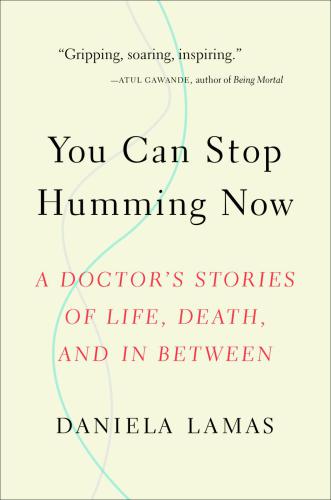
You Can Stop Humming Now
A Doctor's Stories of Life, Death, and in Between
داستانهای زندگی، مرگ و بین آنها
کتاب های مرتبط
- اطلاعات
- نقد و بررسی
- دیدگاه کاربران
نقد و بررسی

January 15, 2018
In this ruminative account of treating patients, Lamas, a pulmonary and critical care doctor at the Brigham & Women’s Hospital and Harvard Medical School, analyzes how the critically ill manage life during and after treatment. She meets people who are neither bitter nor sorrowful about their conditions, but are constantly aware of their precarious states. Among her patients are Van, a grandfather tethered to a battery-operated heart device, which, when fully charged, allows him to camp or fish with his grandson, and Meghan, a young woman who outlives her cystic fibrosis prognosis and attends college, continuing her physical therapy in her dorm room. When Lamas visits Ben, a young man with brain damage, she witnesses a mother revelling in Ben’s small victories, such as when he attempts to make a sandwich. Through these visits and others, Lamas weaves a thoughtful and beautiful narrative: “I wanted to know how they would learn to adapt to new realities and whether they would regret the decisions they had made.” The author wonderfully captures the lives of those who’ve completed treatment and adjusted to a new existence.

January 15, 2018
An unflinching report from the front lines of critical care medicine, a technology-driven field in which doctors routinely save patients' lives--sometimes at great cost to their physical and mental health.Incredible advances in medical technologies and treatments have created a new class of patient: those who survived a significant illness because of an emergency intervention. Such interventions may include surgery to help your lungs breathe, your heart pump blood, or your kidneys process waste. Often, a machine keeps you alive. Only a minority of patients who undergo such procedures make it home, and even fewer return to lives that resembled those they lived before they spent time in the hospital. Yet critical care gives patients and their families hope, and many people choose without hesitation to undergo any procedure that may extend their lives. Lamas, a critical care doctor and faculty member at the Brigham & Women's Hospital and Harvard Medical School, moves beyond the hospital to tell the stories of these survivors. Through beautiful storytelling, she traces the lives of patients after the initial relief of being alive is shadowed by the new reality of recovery and self-care. One mother waited years to receive a lung transplant and would have died waiting were it not for a machine that could oxygenate blood outside of her body, bypassing her lungs and heart. Then there is the popular neighborhood father who would do anything for a new kidney and a grandfather who plugs into the wall every night to keep his heart pumping blood so he can get to know his grandson. Without exception, each of the people the author met is exceptionally motivated to make the most of his or her second chance. Their stories are heart-rending and inspiring, and it is evident that Lamas is deeply moved by the consequences of the actions she and other doctors take every day.An enthralling reminder that behind every medical advance are the people whose lives it affects and that their stories have impact.
COPYRIGHT(2018) Kirkus Reviews, ALL RIGHTS RESERVED.

February 1, 2018
Lamas, a critical care physician (Harvard Medical Sch.), explores how life-extending advances in medical technology alter the lives of ordinary people by telling the stories of patients she encountered and sometimes befriended in the course of her clinical work. The author covers advances in treatment for conditions as varied as lung transplants, cystic fibrosis, extracorporeal membrane oxygenation, and brain injury. Lamas does not simply give biological explanations of these conditions; she uses patients' moving accounts to explore the benefits and hardships associated with these advances in a way few writings do. She also notes the ways in which patients are resilient and strong enough to form lives of meaning and purpose in the midst of illness. These are case studies at their best, attentive to movements such as narrative medicine that call for clinicians to understand illness in not only a biological context, but in the context of an entire life. VERDICT This thoughtful, reflective, and beautifully rendered book examines the costs of modern medicine. Readers who enjoy books by Oliver Sacks and Atul Gawande, or Paul Kalanithi's When Breath Becomes Air will find this volume moving and provocative.--Aaron Klink, Duke Univ., Durham, NC
Copyright 2018 Library Journal, LLC Used with permission.

February 15, 2018
Critical care patients have life-threatening conditions ranging from deadly cardiac arrhythmias to multiple organ failure. These conditions require intensive monitoring from clinicians and often lead to invasive medical interventions. Lamas, a critical care physician, reflects on her experience caring for such patients and their families in this stirring memoir. She follows the care of a handful of patients, providing intimate accounts of how their experiences in critical care impacted their lives in the short term and continue to shape their lives today. Lamas touts the successes of modern medicine but does not shy away from acknowledging unintended negative consequences of life-saving interventions, including patients suffering from PTSD after stints in critical care. Lamas somehow manages to be both clinical and compassionate and beautifully conveys how the line between life and death is not always clear and that we must consider recovery and quality of life when making medical decisions. An important read for anyone involved with, affected by, or curious about critical care medicine.(Reprinted with permission of Booklist, copyright 2018, American Library Association.)

























دیدگاه کاربران